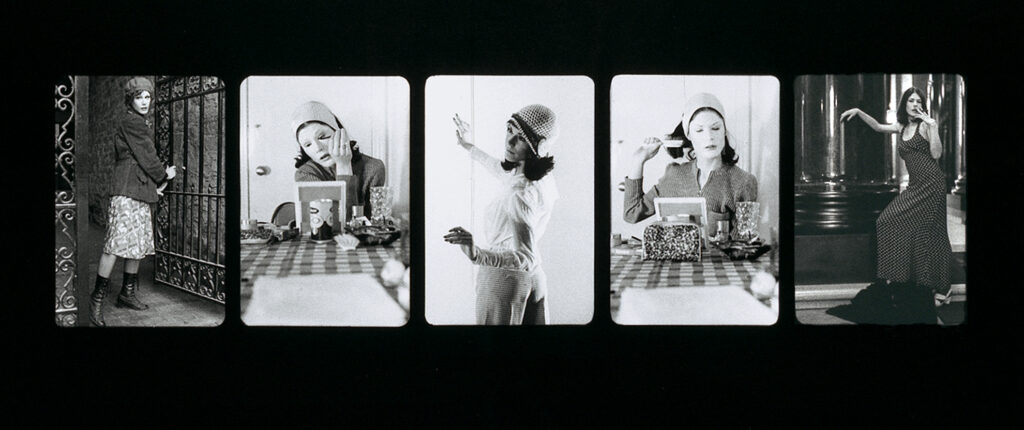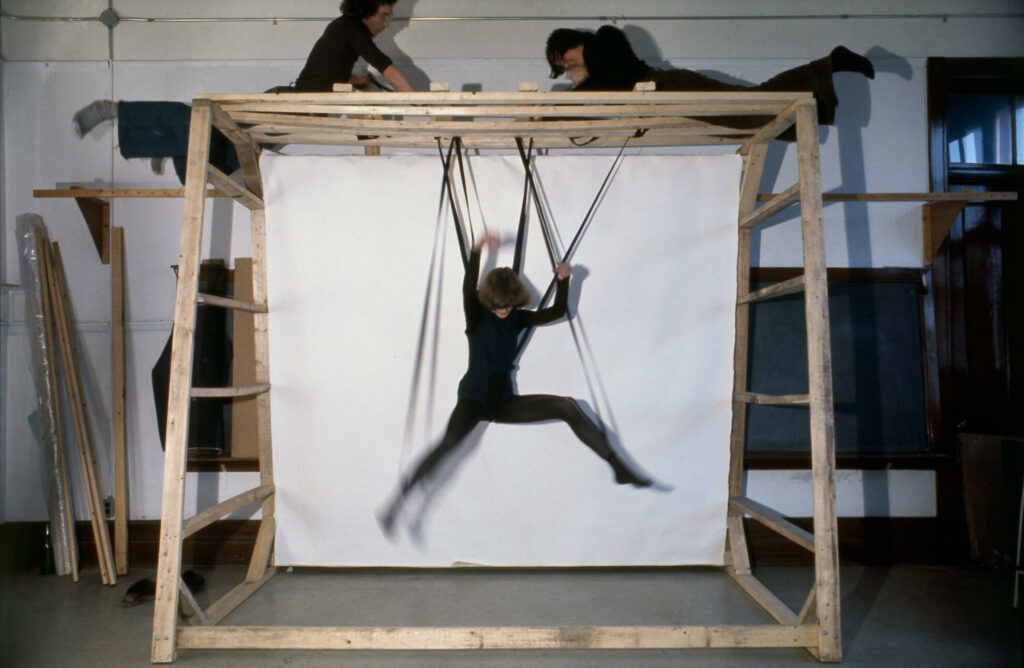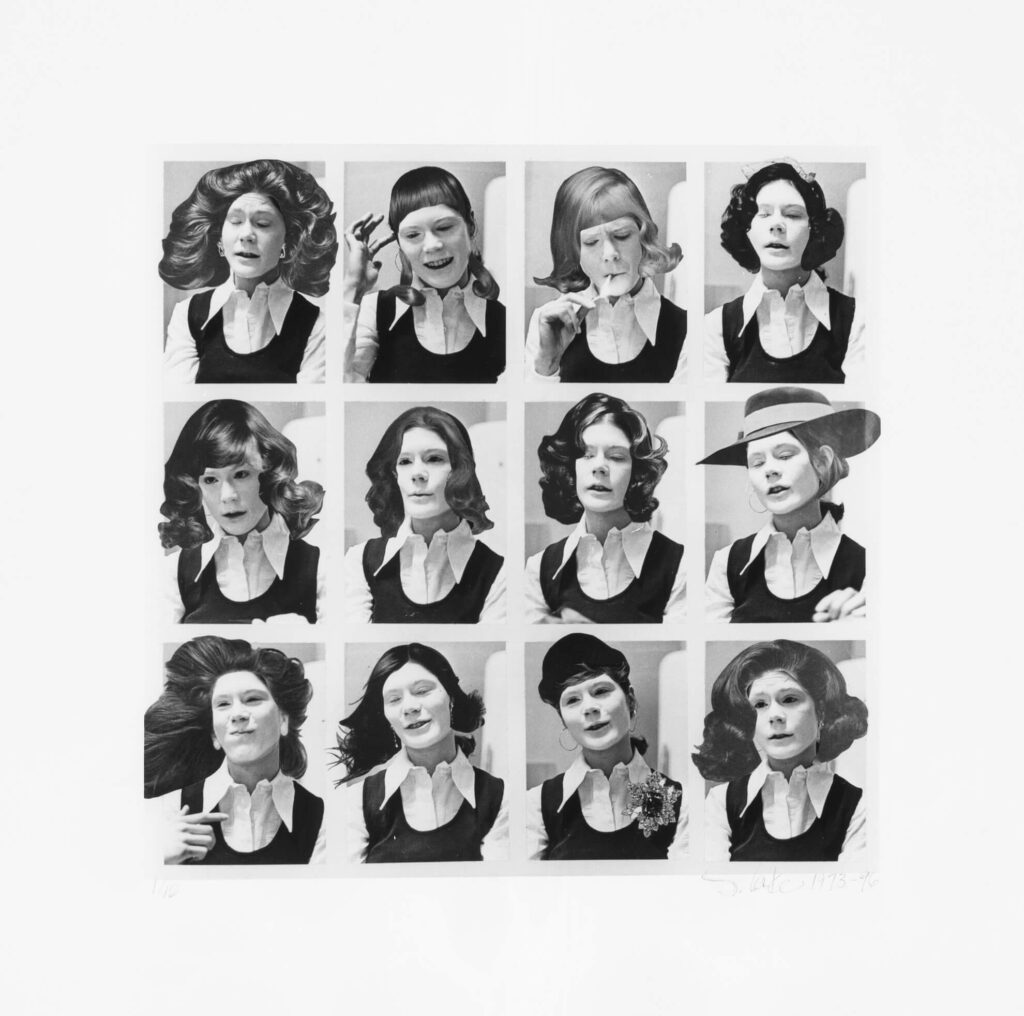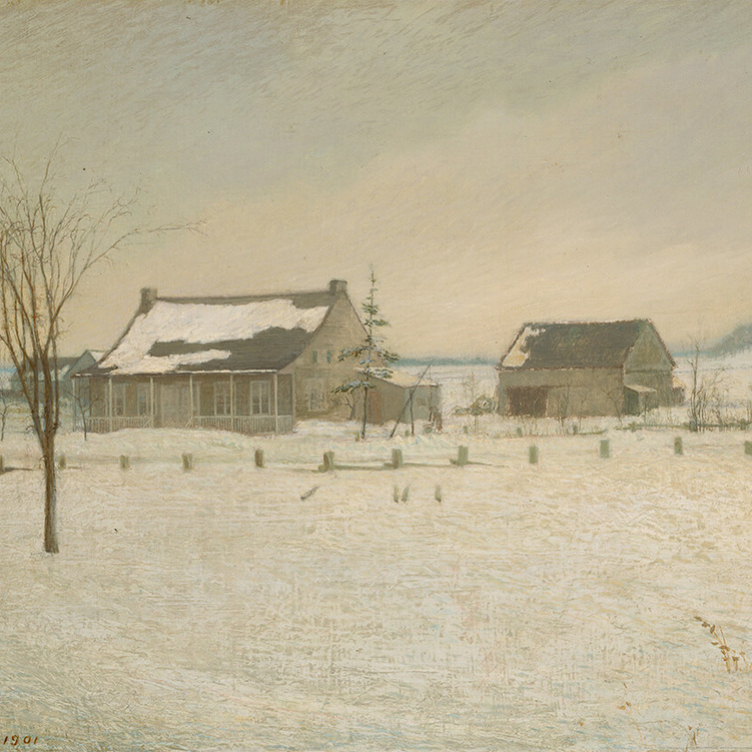One of the most important photo-based practitioners working today, Canadian artist Suzy Lake (b.1947) is known for making herself the subject of her pictures and using her camera as a tool to investigate how we construct images of identity. Through her own experience with the civil rights and anti-war movements in Detroit, Lake became interested in exploring the identity of her generation. In the early 1970s she was exposed to feminist artists including Adrian Piper (b.1948), Nancy Spero (1926–2009), and Martha Wilson (b.1947), who were also studying subjectivity and identity formation and the possibilities afforded by the photographic medium for these investigations.
Through photographic portraiture, Lake examined issues of identity in works such as On Stage, 1972–74, that, paired with an interest in role-playing, formed the basis for an early relationship between performance and photography. In this series, Lake performed for the camera, and the resulting photographs served a double function as artwork in themselves and as a documentation of the performance. In 1973 she took up the camera to produce Imitations of the Self, one of the first of her works to consider how identity is formed within the self and in relation to society, reflecting her lifelong preoccupation with forms of civic awareness and engagement.
Identity is a constant source of interrogation for Lake: in the “masking” in her whiteface photo-performances from the early 1970s (Miss Chatelaine, 1973; Imitations of Myself #1, 1973/2012; A Genuine Simulation Of…, 1973/1974); in the transformation of the self in Suzy Lake as Gary William Smith, 1973–74; or in the submission of the self to others in Choreographed Puppets, 1976–77. From the 1970s to the early 1980s Lake figured centrally in her own work, not to convey a biographical sketch but to excavate a more general “self” in relation to society as well as “the self” as a construct.

Gelatin silver print, selenium toned, 40.1 x 91.3 cm, Art Gallery of Ontario, Toronto.
Nevertheless, Lake’s broader concern was for the self in relation to society. Mass media had made images and products associated with self-fashioning ubiquitous, often directing advertising at women consumers through beauty magazines, and these provided fertile terrain for Lake. Her work from the 1970s—notably, her fascination with media, framing, and perception—anticipates the movement that, late in the decade, came to be known as the “Pictures” generation. This group of artists was interested in representational imagery and mass media. Curator and art historian Douglas Crimp was the first to attempt to identify their new technique and style in his 1977 exhibition Pictures, where, he noted, they created works by exploring “processes of quotation, excerptation, framing, and staging.”

Cibachrome print, 40.6 x 50.8 cm, Georgia Scherman Projects, Toronto.
During the 1980s Lake ceased to appear as a subject in her work in order to focus her lens on specific political struggles. In 1994, Lake returned to depicting herself with the series My Friend Told Me I Carried Too Many Stones, 1994–95, and Re-Reading Recovery, 1994–99, at this time also recognizing the experience of the aging body and the older woman as a site to explore. In remarkable series from these years, Lake exaggerates the stereotypes of aging (Peonies and the Lido, 2000–2006, playing off the melodramatic depictions of death and aging by Dirk Bogarde in the 1971 film adaptation of Thomas Mann’s 1912 novella Death in Venice); magnifies the nuance and nuisance of continuing to role-play femininity in mainstream society (Beauty at a Proper Distance, 2000–2008); and defies the societal expectations placed on older women in society (Forever Young, 2000).

3 light-jet chromogenic prints; 101.6 x 137.2 cm, 101.6 x 141 cm; 101.6 x 137.2 cm, Georgia Scherman Projects, Toronto.
The photographic self-portraiture of Lake and her contemporaries has been viewed by many commentators as anticipating the advent, in the 2010s, of “selfie culture,” the vernacular practice of taking photographs of oneself using smartphone cameras, often resulting in the circulation of these images on social media platforms such as Instagram. However, the selfie is usually intended to suggest a spontaneous approach to self-portraiture, which differs from Lake’s practice in that her images and process are slow, representing her preoccupation with time and process. Although Lake is invested in media and social perception, she engages with popular media as a critique rather than an exaltation. The selfie is vernacular, unskilled; Lake’s work is technically masterful. The selfie is about “my” self; Lake’s work is about “the” self.

Gelatin silver fibre-based print (printed 1996), 22.3 × 22.4 cm, Metropolitan Museum of Art, New York.
This Essay is excerpted from Suzy Lake: Life & Work by Erin Silver.
 Karen Tam’s Autumn Tigers
Bridging Past and Present: Invisible Made Visible
By Imogene L. Lim, PhD
Karen Tam’s Autumn Tigers
Bridging Past and Present: Invisible Made Visible
By Imogene L. Lim, PhD
 The Frontier Portraits of C.D. Hoy
A Chinese Canadian Photographer’s Tribute to His Community
By Faith Moosang
The Frontier Portraits of C.D. Hoy
A Chinese Canadian Photographer’s Tribute to His Community
By Faith Moosang
 An Emboldened Artist
How Oviloo Tunnillie achieved rare international acclaim as an Inuit female sculptor
By Darlene Coward Wight
An Emboldened Artist
How Oviloo Tunnillie achieved rare international acclaim as an Inuit female sculptor
By Darlene Coward Wight
 Painting the Cultural Mosaic
William Kurelek traversed the country in a quest to capture its diverse inhabitants
By Andrew Kear
Painting the Cultural Mosaic
William Kurelek traversed the country in a quest to capture its diverse inhabitants
By Andrew Kear
 Domestic Discontent
Mary Pratt’s poetic scenes of home life are praised for their political edge
By Ray Cronin
Domestic Discontent
Mary Pratt’s poetic scenes of home life are praised for their political edge
By Ray Cronin
 A New Vision of the North
Annie Pootoogook’s art offers unprecedented insights into the contemporary Arctic
By Nancy G. Campbell
A New Vision of the North
Annie Pootoogook’s art offers unprecedented insights into the contemporary Arctic
By Nancy G. Campbell
 Meetings of Minds
Sorel Etrog found new ideas in collaborative work
By Alma Mikulinsky
Meetings of Minds
Sorel Etrog found new ideas in collaborative work
By Alma Mikulinsky
 Introducing Miss Chief
An excerpt from the ACI’s book “Revision and Resistance”
By Shirley Madill
Introducing Miss Chief
An excerpt from the ACI’s book “Revision and Resistance”
By Shirley Madill
 A Practice of Recovery
An excerpt from the ACI’s book “Revision and Resistance”
By Sasha Suda
A Practice of Recovery
An excerpt from the ACI’s book “Revision and Resistance”
By Sasha Suda
 Decolonizing History Painting
An excerpt from the ACI’s book “Revision and Resistance”
By Ruth B. Phillips and Mark Salber Phillips
Decolonizing History Painting
An excerpt from the ACI’s book “Revision and Resistance”
By Ruth B. Phillips and Mark Salber Phillips
 A Vision for the Future
An excerpt from the ACI’s book “Revision and Resistance”
By Nick Estes
A Vision for the Future
An excerpt from the ACI’s book “Revision and Resistance”
By Nick Estes
 Inside Kent Monkman’s Studio
An excerpt from the ACI’s book “Revision and Resistance”
By Jami C. Powell
Inside Kent Monkman’s Studio
An excerpt from the ACI’s book “Revision and Resistance”
By Jami C. Powell
 The Rule of Chance
Jean Paul Riopelle’s break with Automatism
By François-Marc Gagnon
The Rule of Chance
Jean Paul Riopelle’s break with Automatism
By François-Marc Gagnon
 From Taos to New York
Agnes Martin and the currents of American Art
By Christopher Régimbal
From Taos to New York
Agnes Martin and the currents of American Art
By Christopher Régimbal
 An Artist Blooms
Mary Hiester Reid’s floral aesthetics
By Andrea Terry
An Artist Blooms
Mary Hiester Reid’s floral aesthetics
By Andrea Terry
 The Patriotic Painter
Greg Curnoe’s Canada
By Judith Rodger
The Patriotic Painter
Greg Curnoe’s Canada
By Judith Rodger
 Walking, Stacking, Dancing
Françoise Sullivan’s conceptual 1970s
By Annie Gérin
Walking, Stacking, Dancing
Françoise Sullivan’s conceptual 1970s
By Annie Gérin
 The Extraordinary North
Tom Thomson’s diary of landscape
By David P. Silcox
The Extraordinary North
Tom Thomson’s diary of landscape
By David P. Silcox
 A Champion of Abstraction
Jock Macdonald sought a new expression in art
By Joyce Zemans
A Champion of Abstraction
Jock Macdonald sought a new expression in art
By Joyce Zemans
 Defiant Spirit
Quebecois artist Ozias Leduc drew on Europe but created a Canadian ideal
By Laurier Lacroix
Defiant Spirit
Quebecois artist Ozias Leduc drew on Europe but created a Canadian ideal
By Laurier Lacroix